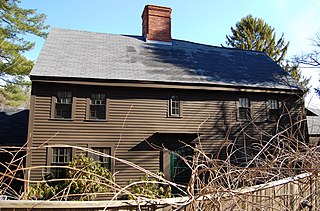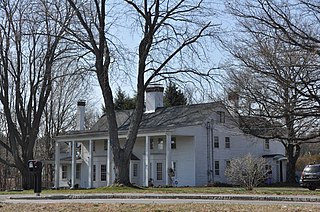
The Spencer–Peirce–Little Farm is a Colonial American farm located at 5 Little's Lane, Newbury, Massachusetts, United States, in the midst of 231 acres (93 ha) of open land bordering the Merrimack River and Plum Island Sound. The farmhouse, dating to c. 1690, was designated a National Historic Landmark in 1968 as an extremely rare 17th-century stone house in New England. It is now a nonprofit museum owned and operated by Historic New England and open to the public several days a week during the warmer months; an admission fee is charged for non Members.

The Fairbanks House in Dedham, Massachusetts is a historic house built ca. 1641, making it the oldest surviving timber-frame house in North America that has been verified by dendrochronology testing. Puritan settler Jonathan Fairbanks constructed the farm house for his wife Grace and their family. The house was occupied and then passed down through eight generations of the family until the early 20th century. Over several centuries the original portion was expanded as architectural styles changed and the family grew.

The Richard Jackson House is a historic house in Portsmouth, New Hampshire. Built in 1664 by Richard Jackson, it is the oldest wood-frame house in New Hampshire. It was designated a National Historic Landmark in 1968. It is now a historic house museum owned by Historic New England, and is open two Saturdays a month between June and October.

The John Ward House is a National Historic Landmark at 132 Essex Street in Salem, Massachusetts, United States. With an early construction history between 1684 and 1723, it is an excellent example of First Period architecture, and as the subject of an early 20th-century restoration by antiquarian George Francis Dow, it is an important example of the restoration techniques. Now owned by the Peabody Essex Museum, it is also one of the first colonial-era houses in the United States to be opened as a museum. It was designated a National Historic Landmark in 1968.

The Wheeler-Merriam House is a historic house located at 477 Virginia Road in Concord, Massachusetts. With a construction history dating to about 1692, it is one of Concord's oldest buildings. It is also notable for having joinery by Abner Wheeler, a prominent local builder of the late 18th century, and for its long association with the locally prominent Wheeler and Merriam families. It was added to the National Register of Historic Places on November 26, 1982.

The Whitcomb Inn and Farm is an historic farm at 43 Old Sugar Road in Bolton, Massachusetts. The oldest portion of the farmhouse, which is believed to be the oldest building in Bolton, is estimated to have been built c. 1708, when David Whitcomb acquired the land from his father. The rear leanto section with a "Beverly jog" was built about 10 years later, and an extension ell was added to the east of the house later in the 18th century. The building underwent stylistic changes in the 19th century, most of which were removed during a major restoration in 1937–38 by Philip Phillips.

The Willard-Fisk House is a historic farm property at 126 Whitney Street in Holden, Massachusetts. The farmhouse, built about 1772, is one of the oldest houses in Holden, and one of its oldest brick houses. The property also includes a 19th-century barn and several 20th-century farm outbuildings. The property was listed on the National Register of Historic Places in 1996, where it is listed at 121 Whitney Street.

The John Boardman House is a historic First Period house in Boxford, Massachusetts. Its oldest portion dates to about 1740, but has stylistically older elements. It was moved to its current location from Saugus in 1956, before which it had undergone restoration. It was listed on the National Register of Historic Places in 1990.

The Austin Brown House is a historic late First Period house in Hamilton, Massachusetts. The oldest part of the house is the central core, a 2+1⁄2-story structure with a central chimney, was built c. 1725. A leanto section was added to the rear in the 18th century, and an ell was added to the left in the 19th century. At some point the leanto section was raised to a full two stories. In 1907, the house underwent significant restoration and enlargement, adding the right-side wing and replacing the roof with a higher pitch one with three gable dormers. The exterior was stuccoed at this time. Despite these changes, the First Period core of the house is largely preserved.

The Carlton-Frie-Tucker House is a historic First Period house in North Andover, Massachusetts. It is a rare example of a period building that was moved and added onto another which had been damaged by fire. The oldest portion of the house, its east side and center chimney, were probably built c. 1709 by Ebenezer Frie. The west side of the house is a second structure that was attached to the first in the 1760s, with some documentary and physical evidence that this was due to a fire destroying the original west side. A leanto section was added to the rear of the house in the 20th century, as was a wing on the northwest corner, connecting the house to its barn.

The Rea Putnam Fowler House is a historic house in Danvers, Massachusetts. It is a 2+1⁄2-story timber-frame structure, five bays wide with a side gable roof, clapboard siding, and a slender central chimney. A leanto section extends to the rear, giving the house a classic saltbox profile. The leanto section extends beyond one of the sides, creating what is called a "Beverly jog". The front entrance is centered, and is sheltered by a late 18th or early 19th-century porch. The oldest portion of the house, its western three bays and leanto, was built about 1700, and the eastern bays were added about 1725. The original chimney was quite large; the present chimney is a 19th-century replacement, and a second chimney in the leanto is a 20th-century addition. The house underwent a historically sensitive restoration in the 1930s, under the auspices of the Society for the Preservation of New England Antiquities.

The Newman–Fiske–Dodge House is a historic First Period house in Wenham, Massachusetts. The house contains a rare instance of preserved 17th century decoration. Like many First Period houses, it was built in stages. The first part, the now-central chimney and right-side two stories, was built c. 1658, with the left-side rooms being added c. 1695–96. The fireplace in the right-side room contains original detailing that was covered over by paneling sometime in the 18th century, and the trim on the staircase to the second floor was probably added at the time of the addition.

The Col. John Osgood House is a historic late First Period house in North Andover, Massachusetts. The original part of the house, its left side, was built c. 1720. A second, similar building was then attached to the right side of the chimney at a later date, demonstrating an unusual method of joining the two structures. The house was listed on the National Register of Historic Places in 1990.

The Sawyer House is a historic First Period house in Boxford, Massachusetts. It is a 2+1⁄2-story central-chimney house with an attached rear two-story wing. A two-story full-width portico supported by seven turned columns shelters the front of the house. Like many First Period houses, this one was built in stages, and exhibits a variety of architectural styles despite its early origins. The first portion to be built was the center chimney and the two-story section to its right, in c. 1700. Later in the First Period the rooms to the left of the chimney were added. The rear wing was added in the 19th century, as was the front portico. There two further additions in the 20th century, including a sun room at the rear where the 19th-century addition meets the main house, and single-story shed-roofed addition on the west gable end, running the full depth of the house.

The Abel Allen House is a historic house located in Weston, Massachusetts.

The Ephraim Buck House is a historic First Period house in Wilmington, Massachusetts. Construction of the house has been dated to c. 1704 by deeds, although local histories suggest part of it may be older. Analysis of its framing suggests that it may have been built in phases: the first phase would have included the front half of the house, along with a central chimney, while the back portion of the house, along with a new chimney, would have been added later in the 18th century. The house is distinctive for having "Beverly jogs" on both sides of the house; this is a portion of the rear section that projects from the side of the house. The house was supposedly built by Roger Buck, an early colonial settler, and his son Ephraim, and was originally occupied by two families. Its exterior was restyled c. 1770 to give it Federal period styling, including a front door entry with 3/4 length sidelight windows and an entablature.

The Abraham Jaquith House, also known as Farley Garrison house, was a historic house in Billerica, Massachusetts. Built about 1725, it was one of the oldest surviving colonial era houses in the town, prior to its deconstruction in 2000. It was listed on the National Register of Historic Places in 1991.

The Daniel Morse III House is a historic First Period house at 210 Farm Road in Sherborn, Massachusetts. With its oldest portion dating to about 1710, it is one of the town's oldest surviving buildings. It was listed on the National Register of Historic Places in 1986.

The Millard–Souther–Green House is a historic house at 218 Green Street in Stoneham, Massachusetts. Built c. 1700, it is one of the oldest buildings in Stoneham. It is a two-story timber-frame structure with an asymmetrical four-bay facade. The entry is in the second bay from the left, with the slightly off-center large brick chimney behind. It has an added rear leanto section, giving it a classic saltbox profile. The window openings appear to be original in terms of size and position, a rarity for Stoneham's 18th-century houses.

Oak Grove Farm is a historic First Period farmstead in Millis, Massachusetts. The 2+1⁄2-story wood-frame farmhouse was probably built in three phases, the first of which was in the early 18th century. Around this time, the left five bays of the house were built, as was a central chimney. In the second quarter of the 19th century, three bays were added to the right, giving the building its current asymmetrical eight-bay facade. Finally, in 1884 a series of modifications and additions were made. The central chimney was removed, a leanto section was added to the rear of the house, and the front porch was added. A second porch was also built onto the rear ell around this time.























